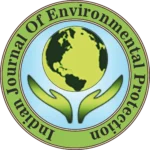IJEP 43(1): 48-54 : Vol. 43 Issue. 1 (January 2023)
Shri Krishna Singh and A.R. Quaff*
National Institute of Technology, Department of Civil Engineering, Patna – 800 005, Bihar, India
Abstract
In this paper, effectiveness of two organic amendments, namely the vermicompost (VC) and rice crop residue (RCR), as a reducer of leaching potential of two pesticides, namely atrazine and carbendazim is presented. The studied soil was a sandy clay loam (1.52% of organic carbon, 53% of sand, 19% of silt and 28% of clay) collected from open field near Phulwarisharif, Patna, India. The soil was amended at the rate of 10% weight by weight with VC and RCR. Pesticide’s breakthrough curves obtained from soil column show the leaching potential of both pesticides but in different proportions. Relatively high reductions in leaching of both pesticides were observed in the RCR amended soil as compared to VC amended soil. Due to rice crop residue the reduction of atrazine leaching was 60.7% whereas due to vermicompost it was only upto 37.3%. Similar trends were obtained with carbendazim pesticides. The reduction of carbendazim leaching due to RCR and VC was 68.8% and 45.3%, respectively. The RCR was found more effective as a barrier for reduction of leaching of the studied pesticides as compared to VC. Results also suggest that rice crop residue is more effective in accumulation of both pesticides as compared to vermicompost.
Keywords
Carbendazim, Atrazine, Leaching, Soil, Crop residue, Vermicompost
References
- Arora, S., et al. 2009. Pesticides, their classification based on WHO and global status of hazardous pesticides (vol VIII). National centre for Integrated Pest Management, New Delhi.
- Ali, I. and C.K. Jain. 1998. Groundwater contamination and health hazards by some of the most commonly used pesticides. Curr. Sci., 75(10):1101-1114.
- EPA. 2011. Types of pesticides. U.S. Environmental Protection Agency, NC, USA. Available at : http://www.epa.gov/opp00001/about/types.htm.
- Alferness, P. and L. Wiebe. 2002. Determination of mesotrione residues and metabolites in crops, soil and water by liquid chromatography with fluorescence detection. J. Agric. Food Chem., 50:3926-3934.
- Hildebrandt, A., et al. 2008. Impact of pesticides used in agriculture and vineyards to surface and groundwater quality (North Spain). Water Res., 42:3315-3326.
- Baran, N. and L. Gourcy. 2013. Sorption and mineralization of S-metolachlor and its ionic metabolites in soils and vadose zone solids : Consequences on groundwater quality in an alluvial aquifer (Ain Plain, France). J. Contam. Hydrol., 154:20-28.
- Aquence de I’eau Adour-Garonne. 2012. Qualite des eaux et products phytosanitaries surle basin Adour Garonne. Situation en. pp 11.
- BCMA report. 2015. Environmental fate. British Columbia Ministry of Agriculture. Available at: http://www.agf.gov.bc.ca/pesticides_2.htm.
- Fishel, F. 2005. Pesticides and the environment. Department of Agronomy, University of Missouri Extension.
- Fenoll, J., et al. 2011. Use of farming and agro-industrial wastes as versatile batteries in reducing pesticides leaching through soil columns. J. Hazard. Mater., 187:206-212.
- Zhytniewski, R. and B. Buszewski. 2002. Sorption of pesticides in soil and compost. Polish J. Env. Studies. 11:179-184.
- Huggenberger, F., J.J. Letey and W.J. Farmer. 1973. Adsorption and mobility of pesticides in soil. California Agric., 8-10.
- Herbst, M., et al. 2005. Intercomparison of flow and transport models applied to vertical drainage in cropped lysimeters. Vadose Zone J., 4:240-254.
- Mamy, L., B. Gobnelle and E. Baftiuso. 2008. Measurement and modelling of glyphosate fate compared with that of herbicides replaced as a result of the introduction of glyphosate resistant oilseed rape. Pest Manage. Sci., 64:262-275.
- Arvalis. 2013. Institut du vegetal. Available at: http://www.arvalistristitutduvegetal.plugins/WMS_BO_Gallery.
- Johnson, C.J., et al. 1996. Preferential flow pathways and their capacity to transport-isoproturon in a structured clay soil. Pest. Manage. Sci., 48(13):225-237.
- Majumdar, K. and N. Singh. 2007. Effect of soil amendments on sorption and mobility of metribuzin in soils. Chemosphere. 66:630-637.
- Rodriguez-Cruz, M.S., et al. 2011. Enhanced retention of linuron, alachlor and metalaxyl in sandy soil columns intercalated with wood barriers. Chemosphere. 82:1415-1421.
- Raquel, R., et al. 2013. Enhancing soil sorption capacity of an agricultural soil by addition of three different organic wastes. Sci. Total Env., 458-460:614-623.
- Marin-Benito, J.M., et al. 2013. Use of raw or incubated organic wastes as amendments in reducing pesticide leaching through soil columns. Sci. Total Env., 463-464:589-599.
- Ministry of Agriculture. 2011. Method manual for soil testing in India. Department of Agriculture and Cooperation, Ministry of Agriculture, Govt. of India, New Delhi.
- APHA. 1995. Standard methods for the examination of water wastewater. American Public Health Association.
- Gustafson, D.I. 1989. Groundwater ubiquity score. A sample method for assessing pesticide leachability. Env. Toxicol. Chem., 8:339-357.
- Singh, S.K. and A.R. Quaff. 2021. Comparative study of leaching potential of atrazine and carbendazim pesticide in low organic content soil. Indian J. Env. Prot., 41(6):621-626.
- AERU. 2010. The pesticide properties database (PPDB). Agriculture and Environment Research Unit, The University of Hertlordshire, U.K. Available at: http://www.herts.ac.uk/aeru/foot print.
- OECD. 2007. Guidelines for testing of chemical. No. 312. Leaching in soil colums. Organization
for Economic Cooperation and Development, Paris. - Johnsona, A.C., et al. 1997. The potential of incorporated organic matter to reduce pesticide leaching. In Toxicological and environmental chemistry (vol. 58). pp 1-4.
- Alletto, L., et al. 2013. Sorption and mineralization of S-metelachlor in soils from fields cultivated with different conservation tillage systems. Soil Tillage Res., 128:97-103.
